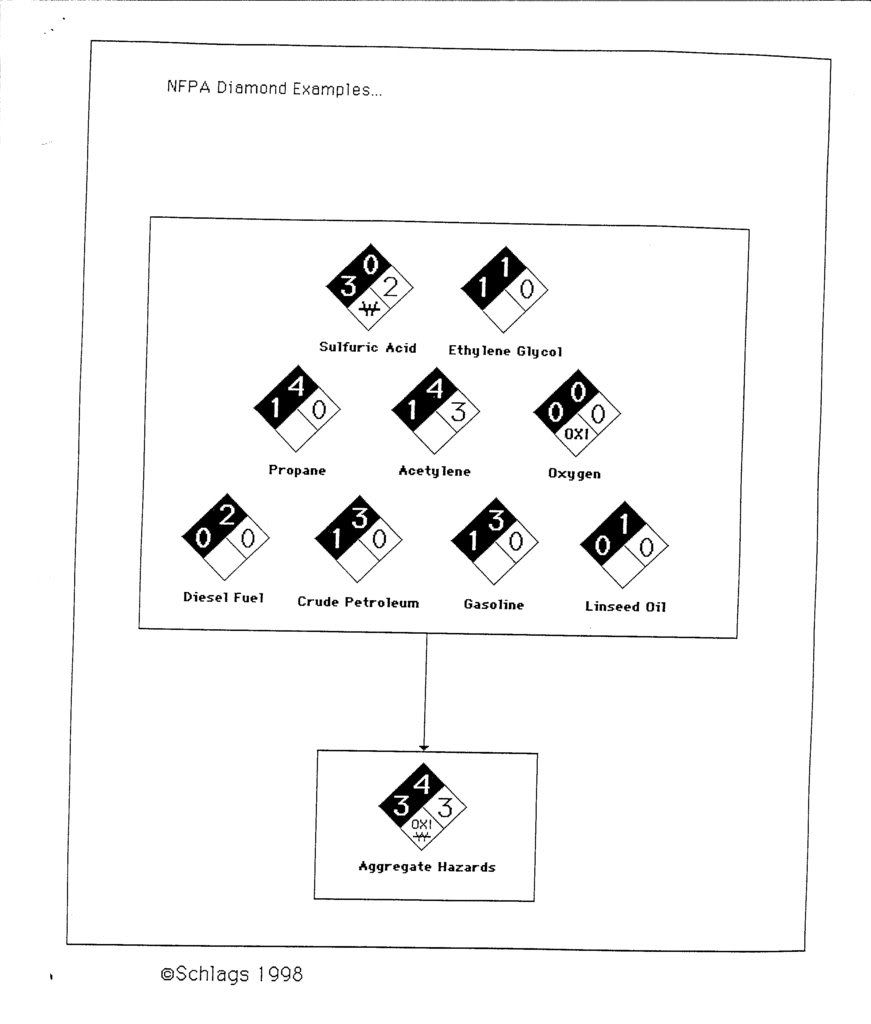How To Determine NFPA 704 Hazard Diamond Info Example

When helping a business determine what information should be placed on an exterior NFPA 704 Hazardous Materials Placard it is important to understand that this placard is used to capture the worst case scenario for each chemical that is stored, used or handled on site in quantities that in some situation can be very small quantities and large amounts for others. One thing for sure is that what triggers the use of the NFPA 704 is when there are what the fire code calls permitable quantities or in other words, there is a chance that something can happen, and it's usually not a good thing because the various hazardous materials pose health and / or physical hazards to people.
Putting the correct NFPA 704 info on the placard is essential for first arriving company officers to accurately size up potential hazards.
Mike's Hint #1: A general rule of thumb for determining worst case scenario PPE requirements is to look at the health hazards (blue background).
4 = Level A
3 = Level B
2 = Level C
1 = Level D
Mike's Hint #2: There is no better way to teach someone how to label a NFPA 704 than to show them the below graphic I put together to explain this. No need to type out a lot of instructions here, it should be pretty straight forward...

As always, I hope you find this a helpful way to help businesses correctly label a NFPA 704 Hazard Warning Placard.
TCSS, Mike from Santa Barbara
Tags:
Replies to This Discussion
-
Permalink Reply by Bill Muehsam on October 4, 2008 at 8:12pm
-
Mike,
As a Hazmat Instructor, you have touched on a subject that is "near and dear" to my heart. Once again, GREAT INFO for the FF's out in the field. I can't stress enough the need to "get out of the station and out into the district." You, as the first responding unit, should never be caught by surprise or hear the Apparatus CPT say "I didn't know that was here" or "I didn't know that they had that stuff here". Get out in the district and meet with your local business owners. Find out what they do (what kind of business), how they do it (know the process), and where they do it (tour the facility). Find out what chemicals they store and use, what quantities they have on the site, and where it's stored. Preplanning is the key to a good response. It won't cover every possible incident, but it will greatly assist first responding units on an incident involving a business using and/or storing hazardous materials. The NFPA 704 System will assist you in this preplanning.
One of our major problems is however, that the NFPA 704 Marking System is not mandatory in all places. I wish I could wave a magic wand and make it federal law or state law in all 50 states, the territories, and the District. It could, and probably has, saved the lives of countless first responders all over the US.
-
Permalink Reply by Mike Schlags (Captain Busy) Retd on October 4, 2008 at 9:14pm
-
If your state has adopted the Uniform Fire Code, then the NFPA requirements can easily by applied.
-
Permalink Reply by lutan1 on October 6, 2008 at 2:23am
-
Yet another example Mike of non standard markings across the globe.
We see these occasionally, but most common here in the great land down under is the HAZCHEM CODE.
I'll track down some pix and explain it over the next few days....
-
Permalink Reply by Mike Schlags (Captain Busy) Retd on October 6, 2008 at 8:11pm
-
I look forward to learning how you placard fixed facilities. We can learn from one another... : ) ms
-
Permalink Reply by lutan1 on October 6, 2008 at 8:43pm
-
I'm not 100% up to date, but I beleive the requirement to placard facilities has now been removed. No longer required. Tony P may be able to clarify further.
The hazchem code I mentioned above is used on all chemicals, MSDS, etc here...
Here's a PDF of the card that most first responders carry on them when attending HAZMAT incidents- it explains the system quite well and can be downloaded at:
http://www.worksafe.vic.gov.au/wps/wcm/resources/file/ebd19c435ec5d...
For example, petrol is a class 3 flammable liquid and the HAZCHEM code is 3YE.
That means that for a fire or spill, the firefighters use foam, with SCBA, and need to consider Evacuation. They also need to contain the product.
Does that make sense?
-
Permalink Reply by lutan1 on October 6, 2008 at 8:50pm
-
A couple of other docs that may be of interest-
Safe Operation of Cold Storage Facilities
http://tinyurl.com/53sfu8
This is aimed at the plant owners but may of interest- Chemical Safety Self Assessment Tool
http://tinyurl.com/53l66g
-
Permalink Reply by BillySFCVFD on October 7, 2008 at 12:02pm
-
Mike,
You are by far the best "teacher" on this site, with the info and the methods used to get the point across. I eat it up. Thank you TCSS
-
Permalink Reply by Mike Schlags (Captain Busy) Retd on October 7, 2008 at 2:04pm
-
ah shucks... I guess going through all the master instructor stuff coupled with developing and teaching fire science / hazmat for >30 years might have something to do with it. Plus I love people and communicating clearly... and oh yea, I'm pretty much right brained so the creativity mode in me is usually stuck in hyperdrive. it's good to be appreciated... : ) TCSS, Mike
-
Permalink Reply by VaLeRiE cRaWfOrD on December 25, 2008 at 12:13am
-
i have a qustion want is the name of the Diamond
Specialty Websites
Find Members Fast
Firefighting Videos
© 2025 Created by Firefighter Nation WebChief.
Powered by
![]()
Badges | Contact Firefighter Nation | Privacy Policy | Terms of Service